Pentatonic Finder

Welcome guitar slingers!
The goal of the ”Pentatonic Finder” tutorial is for you to be able to improvise freely across any key changes, anywhere on the neck, and learn how to conceptually visualize scales and keys, and using scale superimposition.
Before launching head on into this tutorial, I must advice you to first backtrack and review my other improvisational tutorials in the right order (for the best results). The order in which they are supposed to be followed are:
Timing and Note Value Alteration
With that said and done, you also need to know your boxes and sometimes think “inside the box”. Sounds contradictory? Read on, and all shall be revealed young Jedi!
What the Pentatonic Finder in essence is about, is to learn how to not only see one scale all over the neck, and how the boxes in that key is interlinked and “all over”, but to learn to see and have immediate access to ALL keys at the same time, regardless of where on the neck you might be. Sounds pretty useful right? Imagine now that you are in the key of A, improvising in the Amin pentatonic, and say you are currently in the 1st position. Then the progression changes key to E. What would most inexperienced players do then? They would jump up to the 12th fret, Emin pentatonic 1st position right? Well, as useful as this might be, this tutorial will enable you to switch keys without leaving your current position of the neck, thereby further expanding your improvisational freedom and flexibility.
Before turning the page to the actual tutorial however, I would like you to find a deck of cards that you are comfortable writing on with a marker (or cut some squares of paper, approx. 2×2”). Another neat thing about the Pentatonic Finder exercises is that you can do this together with a fellow guitarist and really put each other through the paces and push each other to new heights! So get a friend, sign him up to Infinite Guitar as well, and start pushing your boundaries!
Ready? Let’s go!
Part 1, A to D
So, to start off with, we need a chord progression to play over that changes keys. For arguments sake let’s say the progression is A7, D9, C9, G7. Remember, we want to treat this chord change as 4 separate keys, not all part of the same key of A and just play the Amin blues scale on top of it (which could work as well, but that’s not the topic of this tutorial). I will also play a simple improvisational example over each of the changes, staying strictly within the minor blues scale. A tip here is to sing along with your playing, to help your ear grow accustomed to the changes, but also to force your fingers to play more melodically and not just scalar passages up and down (which no one finds very interesting for very long).
Next, we will choose a area of the neck within which you must stay. Choose an area spanning 6-7 frets, no more than that. I have chosen frets 4-9 for this tutorial.
So, the object is to stay within the confines of this area when the key changes, and superimposing the pentatonics on top of one another, being able to see any key and the corresponding box simultaneously.
Now, record yourself, or have your friend play 4 bars each of these chords round and round (more on the friend or deck of cards approach later on). Then let’s start improvising!
For the first 4 bars of A7, we will need to find the correct box in A within frets 4-9, and which one would that be? You guessed it, box 1, as depicted below.
An explanation of the colors here. I will use different colors to pinpoint different scale degrees throughout the following tutorials (much as I did in the Unlocking the Fretboard tutorial, only several other degrees, hence the different look of the fretboard diagrams this time. The color mapping is as follows:
*The Diamond-shaped dots represents the root, regardless of color.
*The Blue dots (when several colors are used) represents the root as well.
*The Green dots represents the b5 (“blue” note) added to the Minor Pentatonic that turns it into the Blues Scale.
*The Orange dots represents the third degree (minor thirds in this case).
*The Red dots represents the b7 degree (dominant seventh).
We won’t be using all of these in this tutorial, (only the root and b5) but we will in the following ”Note Targeting” tutorial, so familiarize yourself with the color mapping straight away, so you’re not too confused later on.
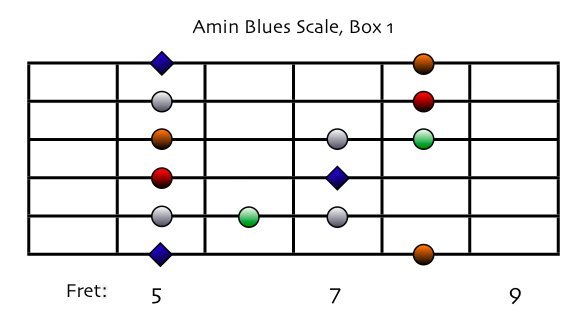
Then, when we come to the next chord in the progression, D7, what box must we utilize? Correct again, (darn you’re good!) the 4th box in D.
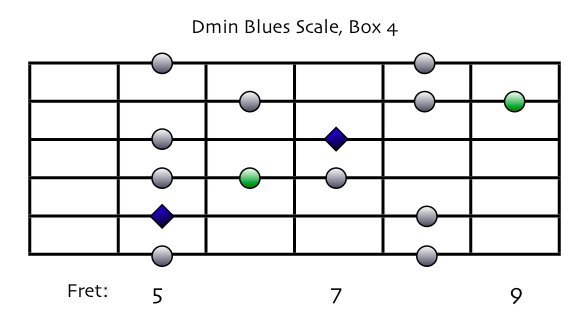
So, in the moment when the change is imminent (in bar 4), try to visualize that 4th box of D, while still playing in A. This is tricky at first, since it often throws you off in your playing to play in one key, whilst thinking of another. If in trouble, I recommend you go through my ”Timing and Note Value Alteration” tutorial, since timing is an invaluable life-saver in this situation! Also, if you’re going to be able to pull off my advanced tapping tutorials, where you need to be able to think not only in these two boxes when changing keys, but in 2-3 positions of each key, in two hands simultaneously all over the neck, you must have this down or you will crash and burn. So you see, even this simple exercise will pay off even in very advanced two-handed improvisation flowing all over the neck later on. This is what I mean by thinking conceptually about technique and theory, to be able to use the concept of the Pentatonic Finder exercise in ANY style or playing situation!
Here is what you should be visualizing when the change comes, the first box of A, superimposed by the 4th box of D. I have omitted the color mapping here for obvious reasons. Look at what notes the two scales have in common and chose a note to target for the change. Initially, the root is a good place to start, since that will really make your key change obvious. Later on, in the ”Note Targeting” tutorial, we will look at other target notes to use, and after that also tension notes.
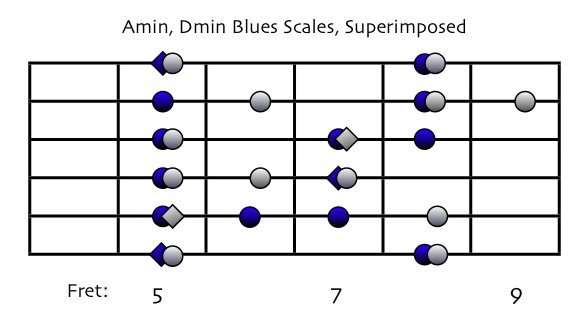
Part 2, D to C
Next, we will look at the next change in the progression, which will be from D9 to C9. We were in the 4th box of the Dmin Blues Scale, so which box must we utilize to keep ourselves within the 4-9 fret area? Right you are, the 5th box in C it is!
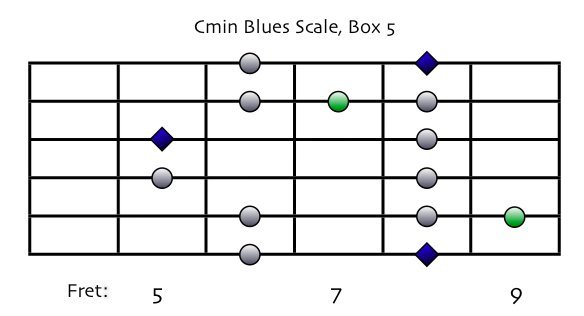
And here is what you should visualize over the change, D 4th position, superimposed by C 5th position
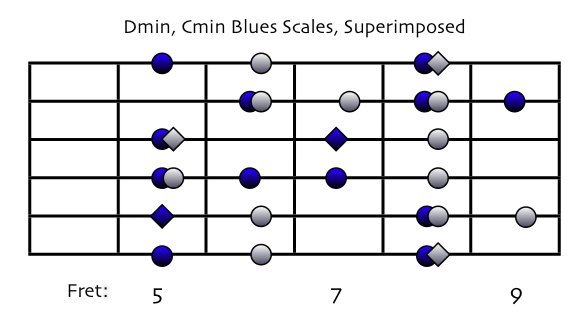
Part 3, C to G
Well, you know the drill by now. Time for the change between C and G. Here’s the correct box in G, which will be the 2nd.
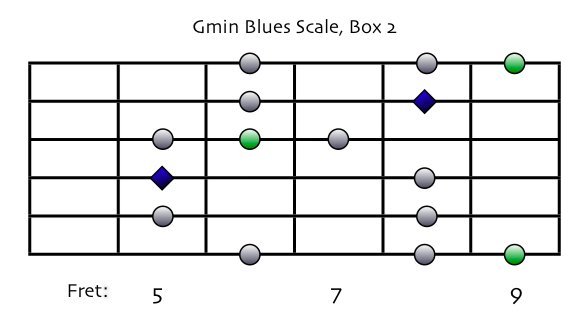
And here’s C superimposed by G.
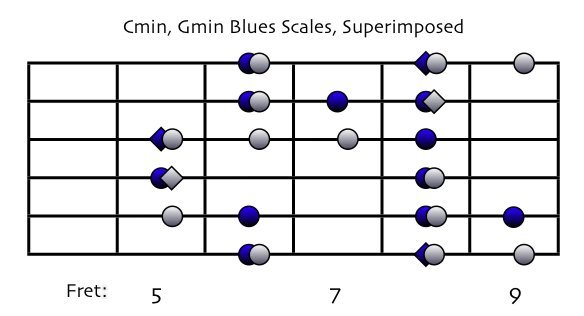
Part 4, G to A
And finally, here’s the change between G7 and A7. You already know that the 1st box of A is what goes, so without further ado, here’s G superimposed by A
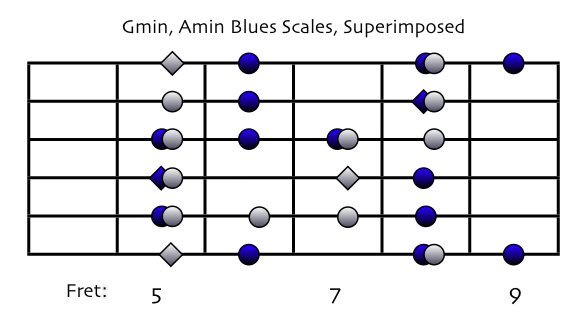
Now What?
Now that you have that down, it’s time to take it to the next level. You should now start practicing this method, choosing new areas of the neck to cover. Say you choose to cover the area of 10-15th fret. If we are in the same progression, A, D, C, G, then what would the corresponding boxes be? Answer is A=4th, D=1st (you could also use the second, your choice, they both fall within the area), C=2nd and G=4th.
Here is where the deck of cards comes into play. You take out all the non-clad cards and write all the 12 chromatic notes on them, they mix them up, and “deal” yourself a progression, record it and get going!
The friend-approach is different. Here you will agree to a starting point, and an area, let’s say A and the 4th-9th fret as we have worked with. Then your friend will play 4 bars of each, but when he has played 2 bars for you, he calls out the name of the key to which he will change after 4 bars, so you have time to think and prepare. This approach is much more random and much harder of course, but a truly great exercise!
If you have some sort of computer or synth-program that can generate random chords, you could possibly work something similar out there, but nothing ever replaces playing with someone else, since while it is your time to play the chords, you can listen and learn by observing what you friend does.
The next step is to take this all over the neck! You will improvise freely across the whole neck, using everything you learned in the Unlocking the Fretboard tutorial. But when the change comes, you must stay in the area of the neck where you currently are, and make that superimposed change then and there, before continuing ripping up the neck.
I wish you good luck with all of this, and I hope to see you again in the next part of my improvisational series, the Timing and Note Value Alteration tutorial.
Keep your groove on!
This article was originally published on Infinite Guitar in 2008 for the Pentatonic Finder tutorial.

.png)
Thanks for that my dear friends!